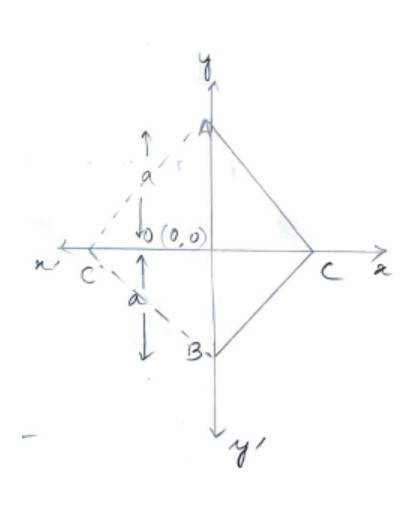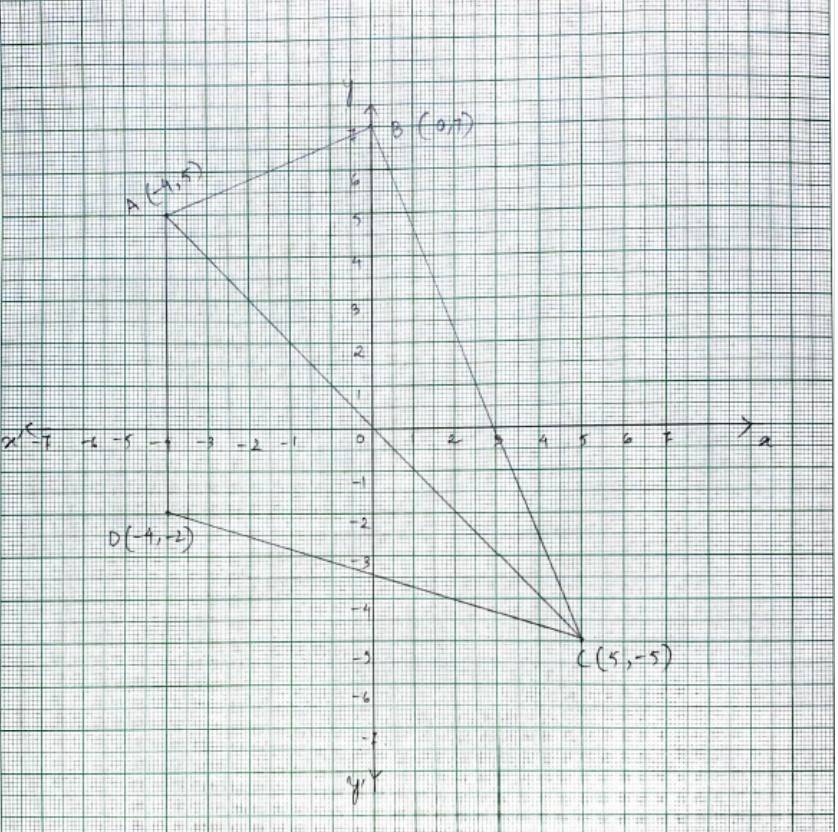Class 11th
Get insights from 8k questions on Class 11th, answered by students, alumni, and experts. You may also ask and answer any question you like about Class 11th
Follow Ask QuestionQuestions
Discussions
Active Users
Followers
New answer posted
6 months agoContributor-Level 10
2. Let ABC be the equilateral triangle of side 2a and 0 be the origin. Then

AB = BC = AC = 2a
O is the mid-point of AB we have AO = a
BO = a
We know that A and B lies on y-axis so they have co-ordinate of the form (0, y).
Hence, co-ordinate of A is (0, a) and that of B is (0, –a)
Since OC, bisects AB at right angle, by Pythagoras theorem,
AC2= OA2 + OC2

And as C we on x-axis it has co-ordinate of the form (x, 0)

New answer posted
6 months agoContributor-Level 10
Exercise 9.1
1. Let the given points be A(–4, 5), B(0, 7), C(5, –5) and D(–4, –2).
Then quadrilated ABCD can be plotted on the graph by joining the points A, B, C and D.

We connect diagonal AC such that
area (ABCD) = (ΔABC) + (ΔADC)
Now,
Similarly,
Hence, area (ABCD) =
New answer posted
6 months agoContributor-Level 10
Volume of the balloon, V = 1425
Mass of the payload, m = 400 kg
Acceleration due to gravity, g = 9.8 m/
= 8000 m
= 0.18 kg m–3
= 1.25 kg m–3
Density of the balloon =
Height to which the balloon will rise = y
Density of air decreases with height and the relationship is given by:
= ……(i)
Differentiating equation (i), we get
, where k is the constant of proportionality
, height changes from 0 to y, while density changes from to . Integrating both sides between the limits, we get:
= -ky
= ….(ii)
From equation (i) and (ii), we get
=&nbs
New answer posted
6 months agoContributor-Level 10
Diameter of the 1st bore, = 3 mm = 3 m
Radius of the first bore, = 1.5 mm = 1.5 m
Diameter of the 2nd bore, = 6 mm = 6 m
Radius of the 2nd bore, = 3.0 mm = 3 m
Surface tension of water, s= 7.3 N/m
Angle of contact between the bore surface and water,
Density of water, kg/
Acceleration due to gravity. g = 9.8 m/
Let and be the heights to which water rises in 1st and 2nd tubes respectively. These heights are given by the relations:
…(i)
…(ii)
The difference in level of water in the 2 li
New answer posted
6 months agoContributor-Level 10
Radius of the narrow tube, r = 1 mm= 1 m
Surface tension of mercury at the given temperature, s= 0.465 N/m
Density of mercury kg/
Dipping depth = h
Acceleration due to gravity, g = 9.8 m/
Surface tension related with angle of contact and dipping depth is given by:
s = or h = = = -5.345 m= -5.345 mm
New answer posted
6 months agoContributor-Level 10
Radius of the uncharged drop, r = 2.0 m
Density of the uncharged drop, = 1.2 kg/
Viscosity of air, = 1.8 Pas
Density of air , can be taken as zero in order to neglect the buoyancy of air
Acceleration due to gravity, g = 9.8 m/
Terminal velocity, v can be written as
v = = = 0.05807 m/s = 5.8 cm/s
The viscous force on the drop is given by
F = 6 = 6 1.8 2.0 0.05807
= 3.9 N
New answer posted
6 months agoContributor-Level 10
The area of the wing of the plane, A = 2 = 50
Speed of air over the lower wing, = 180 km/h = 50 m/s
Speed of air over the upper wing, = 234 km/h = 65 m/s
Density of air, = 1 kg/
Let us assume, pressure over the lower wing = and pressure over the upper wing =
The upward force on the plane can be obtained using Bernoulli's equation:
On lower wing= + , On upper wing = +
From equilibrium of momentum
+ = +
( - )
The net upward force = ( - = )
=&nbs
New answer posted
6 months agoContributor-Level 10
Radius of the artery, r = 2 m
Diameter of the artery, d = 4 m
Viscosity of blood, = 2.084 Pa-s
Density of the blood, = 1.06 kg/
Reynolds's number for laminar flow, = 2000
The largest velocity is given by the relation: =
= = 0.983 m/s
Flow rate is given by the relation:
R = = 3.1416 = 1.235 /s
New answer posted
6 months agoContributor-Level 10
Diameter of the artery, d = 2 m
Viscosity of the blood, = 2.084 Pa-s
Density of the blood, = 1.06 kg/
Reynolds's number for laminar flow, = 2000
= = = 1.966 m/s
As the fluid velocity increases, the dissipative forces become more important. This is because of the rise of turbulence. Turbulent flow causes dissipative loss in a fluid.
New answer posted
6 months agoContributor-Level 10
Gauge pressure, P = 2000 Pa
Density of whole blood, = 1.06 kg/
Acceleration due to gravity, g = 9.8 m/s
Let the height of the blood container = h
Pressure on the blood container P =
By equating, we get h = (2000)/ ( 1.06 = 0.1925m
Taking an Exam? Selecting a College?
Get authentic answers from experts, students and alumni that you won't find anywhere else
Sign Up on ShikshaOn Shiksha, get access to
- 65k Colleges
- 1.2k Exams
- 679k Reviews
- 1800k Answers
